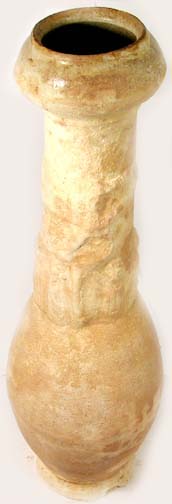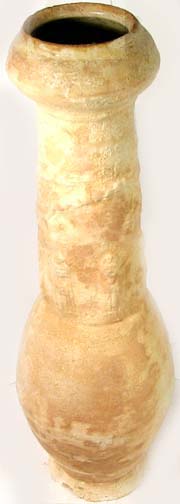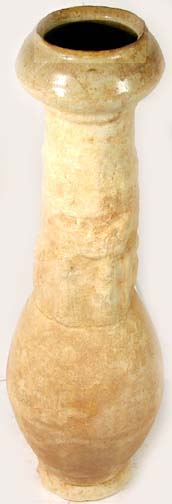













Intact Genuine Ancient Medieval “Celadon Green” Glazed Funerary Offering Ceramic Jar/Vase. Perfect for Use as a Vase for a Dried Floral Arrangement!
CLASSIFICATION: Glazed Ceramic Jar/Vase.
ATTRIBUTION: Ancient China, Song Dynasty (906-1279 A.D.).
SIZE/MEASUREMENTS:
Height: 300 millimeters (12 inches).
Diameter: 94 millimeters (3 3/4 inches) at belly; 69 millimeters (2 3/4 inches) at top of neck (below rim); 47 millimeters (1 7/8 inches) at top lip; 64 millimeters (2 5/8 inches) at base.
CONDITION: Fair, intact, but glaze is heavily oxidized. Chipping to pedestal. Otherwise just the minor bumps and bruises consistent with prolonged burial in the earth. The normal potting blemishes associated with hand production. Missing the original lid.

DETAIL: A glazed earthenware funerary jar from the Song Dynasty of Ancient China. These were used to leave offerings of rice, wine, or some other gift for the deceased. The light green glaze became known as “Celadon Green” – so named for the color – and is one of the most celebrated styles of ancient China. The lower portion of the neck possesses a circumferential display of human figures, believed to represent the deceased’s family or ancestors. Above the ring of figures wrapping around the circumference of the neck is a depiction of a dragon. With respect to this particular specimen, the glaze is heavily oxidized due to caustic alkalinity of soil in which it was buried. There are only patches of the original glaze remaining, those mostly around the top of the neck, above the ring or human figures. You’ll also note that there is quite a bit of chipping to the pedestal. Otherwise the vessel is intact, albeit heavily oxidized, rough, and chalky to the touch. Originally the jar would have had a lid, but it missing.
The dragon symbolizes the Chinese people and the people from Chinese origin considered themselves, with a certain amount of pride, "descendants from the dragon". According to legend, this ancestral dragon was a creature with a deer's antlers, a camel's head, the eyes of a hare, the neck of a serpent, the teeth of a crocodile, claws of an eagle, paws like a tiger, and the ears of a buffalo. Archaeological sites dated from 5,000 to 6,000 B.C. have revealed that the dragon was an allegorical Chinese alligator. This mystical totem was worshiped by the Chinese for centuries. The dragon is also depicted in many forms in modern Chinese art. Ethnic and cultural minorities depict the dragon in many forms, from a fish to an alligator or human.

This mythical creature was capable of ascending to the heavens, and descending to the depths of the sea, and was able to morph from its dragon form into other forms. The Chinese sign for the dragon appears during the Yin and Shang dynasties (16th to 11th centuries B.C.), the period of the earliest Chinese hieroglyphs. Inscriptions found carved into shields constructed of turtle shells depicted a horned reptile, teeth, scales and sometimes paws as well. Above the sign there's often a symbol that seems to indicate that the dragon is considered to be a violent, evil creature, the harbinger of misfortune.
To ancient China, the Chinese dragon ("Lung") was a divinity capable of bringing the rains necessary for the sustenance of China's population. Throughout Chinese history the dragon has been equated with weather. It is believed by many that some of the historically worst floods were caused when mortals managed to displease a dragon. Dragons were also able to create drought, and were capable of eclipsing the sun. The dragon was also a symbol of the emperor, whose wisdom and divine power assured the well being of his subjects. Many ancient legends draw connections between the dragon and the emperor, and some emperors even claimed to have been the divine descendant of a dragon.

Notwithstanding the blemishes described above, there are otherwise only a few minor scuffs, marks, insignificant blemishes, etc. What you would expect to find of a piece of funerary pottery buried a thousand years ago (unfortunately, in caustic, alkaline soil). It’s a long way removed from being in perfect condition, but the condition is not unusual for authentic votive jar like this. Of course realistically one would expect some blemishes after being buried for one thousand years, and in that respect, this jar certainly provides no disappointments. There are as well a few of the customary blemishes (warts, dimples, pimples and pits) which one expects with hand produced ancient earthenware.
Overall it is a good example of this form of ancient funerary pottery. If you’d like an authentic ancient glazed votive jar from the Song Dynasty of Ancient China to proudly display, you could not go wrong with this one. It is solidly shaped, nicely featured, and perfectly proportioned. It would look great with some dried flowers. You could display this one with great pride either at work on your desk or at home. Either way, it will certainly generate curiosity and perhaps even a little envy!

HISTORY OF SONG EARTHENWARE: Fifty years of chaos followed the fall of the Tang Dynasty before the rise of two competing but complementary Dynasties in China; the shorter-lived Liao to the North and the Song to the South. Liao ceramics are unique in form, glaze and design but still utilize Chinese techniques, sometimes showing Tang influence. Liao ceramics are often monochrome white and black similar to that which would be widely produced in the future during the Yuan dynasty. Other Liao ceramics are similar to Tang sancai (three color) lead glazes. The most fundamentally unique characteristics of Laio ceramics were their shapes. To the South, the arts of the Song Dynasty showed introspection and refinement. The Song emperors were among China's most culturally enlightened rulers, many were accomplished artists in their own right. Song ceramics provide a parallel to the era’s renowned landscape painting in their variety and accomplishments.
The finest ceramic products included Ting ware characterized by a milky white glaze and delicately carved or impressed designs. A common motif featured lotus blossoms, which were originally a Buddhist symbol but were often used for decoration in Song secular art. Also highly regarded is vividly colored Chün ware, with splashes of red or purple painted on a blue glazed surface. It was popular in the royal court and was often used for bowls and flowerpots. Classic blue-green celadon and white porcelain continued to be produced in large quantities, most frequently found in the shape of vases. In addition to these royal favorites, a group of popular stoneware, called Tz'u-chou, was manufactured in for local use. The Tz'u-chou potters used a wide variety of decorative techniques, including glazing, painting, incising, and enameling. Chien ware was the favorite of Buddhist monks in Fujian Province who drank their tea from glossy, black-glazed bowls.

During the Song Dynasty porcelain kilns were established at Jingdezhen, where porcelain is still produced today. Jingdezhen became the dominant producer due to its proximity to deposits of high-quality porcelain clay and to two major river systems for transport. Their kilns were particularly successful due to the innovation we know as assembly line techniques. Huge demand came both from a growing Chinese middle class and from foreign merchants, and led to a diversity of shapes, glazes, and decorative motifs. The Song dynasty was the most important dynasty in Chinese porcelain history, and brought prosperity in porcelain production. Amongst the most famous porcelain every produced were exceedingly fine and delicate Ru Kiln wares which used special a glaze with orange carnelian added. The production of Ru ware lasted only 20 years, and today are so rare that only about 70 pieces are known to still exist.
HISTORY OF EARTHENWARE IN ANCIENT CHINA: The first Chinese ceramics archaeologists have found date back more than 10,000 years. These were earthenware, which means they were made from clay and fired at the kind of low temperatures reached by a wood fire or simple oven. In China, most ceramics made before the Tang dynasty (600 A.D.) are earthenware. They may be glazed or unglazed, and are occasionally painted, often brightly colored. Stoneware ceramics are harder and less porous than earthenware and are fired at hotter temperatures—between 2100°F and 2400°F. At these high temperatures, the surface of the clay melts and becomes glassy. Although stoneware is usually waterproof, most stoneware ceramics are glazed for decoration. The glazes often contain ash, which allows the glaze to harden at stoneware temperatures.

During the Shang Dynasty (1600-1100 B.C.) bronze metallurgy superceded ceramics as the favored art form of the ruling class. However both the ceramic and the bronze industries evolved into complex systems of production that were supported by the aristocracy. Decorative designs rich in symbolism were created first in bronze were then imitated in clay. Chinese burial customs included the tradition of placing clay replicas of material possessions, animals and people in the tomb to accompany the deceased and serve them in the next life. Although archaeological finds have revealed that glazed pottery was produced as early as 1100 B.C. during the Zhou dynasty, the production of glazed wares was not common until about 200 B.C. during the Han Dynasty. However from about 1000 B.C. onwards during the Shang and Zhou dynasties, primitive porcelain wares emerged. Real porcelain wares appeared in the Han dynasty around 200 A.D. In the process of porcelain development, different styles in different periods blossomed.
The production of porcelain became widespread by about 500 A.D. Using a special clay with ground rock containing feldspar, a glassy mineral, the material was fired at very high temperatures above 2400°F. The surface of the clay melts at such high temperatures and becomes smooth as glass. Early porcelains were undecorated and were used by the Imperial court and exported as far as the Middle East. For instance during the Han Dynasty principally celadon (green) and black porcelain were mainly produced. The famous blue and white porcelain was created with blue paint made from cobalt and then covered with a clear glaze, which can withstand the high temperatures of the kiln. The technical and creative innovations of Chinese potters are unique accomplishments in the cultural heritage of the world. Today, archaeological excavation and research in China are revealing new sites and new examples of the genius of the Chinese potter.

HISTORY OF THE SONG DYNASTY: The collapse of the Tang Dynasty in 907 A.D. formed the backdrop for the rise the Sung and Liao Dynasties. During the fifty years following the collapse China fragmented into ten different kingdoms, constantly in conflict with one another, and a rapid succession of five dynasties formed and then collapsed. The Five Dynasties period ended in 960 A.D. when a military leader seized the throne and proclaimed the establishment of the Sung (Song) Dynasty (960-1279 A.D.) and reunified most of China. However the Mongols who were responsible for the demise of the preceding Tang Dynasty formed their own kingdom in North China known as the Liao Dynasty (907-1125 A.D.). For the only time in China, the contemporaneous monarchs of both the Liao and Song Dynasties recognized one another as possessing “the mandate of heaven” to rule China as the “son of heaven” – a situation similar to that of Ancient Egypt whereby one Dynasty ruled Upper Egypt, the other Lower Egypt, both Pharaohs recognizing one anothers divine right to rule.
Notwithstanding the shorter-lived Northern Liao Dynasty, the Song Dynasty proved to be the longer lived, and controlled most of China. The founders of the Song Dynasty built an effective centralized bureaucracy staffed with civilian scholar-officials. Notable for the development of cities not only as administrative entities, but also as centers of trade, industry, and maritime commerce, the Sung Dynasty gave rise to a new group of wealthy commoners, the mercantile class. Printing and education spread, private trade grew, and a market economy began to link the coastal provinces and the interior. Landholding and government employment were no longer the only means of gaining wealth and prestige.

Unfortunately fearing a repeat of the anarchy created in the Tang Dynasty by petty military rulers in the frontier areas, the Sung Monarchs severely limited the power and authority of provincial military commanders. They were subordinate to centrally appointed civilian officials who had replaced the regional military governors of the Tang. Though this gave greater power and control to the emperor and his palace bureaucracy, it also led a chronic problem with military weakness. Weakness which proved to be fatal to the Sung Dynasty as they confronted the Mongols under the leadership of Kublai Khan, grandson of Genghis Khan.
HISTORY OF CHINESE CIVILIZATION: Remains of Homo erectus, found near Beijing, have been dated back 460,000 years. Recent archaeological studies in the Yangtse River area have provided evidence of ancient cultures (and rice cultivation) flourishing more than 11,500 years ago, contrary to the conventional belief that the Yellow River area was the cradle of the Chinese civilization. The Neolithic period flourished with a multiplicity of cultures in different regions dating back to around 5000 B.C. There is strong evidence of two so-called pottery cultures, the Yang-shao culture (3950-1700 B.C.) and the Lung-shan culture (2000-1850 B.C). Written records go back more than 3,500 years, and the written history is (as is the case with Ancient Egypt) divided into dynasties, families of kings or emperors. The voluminous records kept by the ancient Chinese provide us with knowledge into their strong sense of their real and mythological origins – as well as of their neighbors.

By about 2500 B.C. the Chinese knew how to cultivate and weave silk and were trading the luxurious fabric with other nations by about 1000 B.C. The production and value of silk tell much about the advanced state of early Chinese civilization. Cultivation of silkworms required mulberry tree orchards, temperature controls and periodic feedings around the clock. More than 2,000 silkworms were required to produce one pound of silk. The Chinese also mastered spinning, dyeing and weaving silk threads into fabric. Bodies were buried with food containers and other possessions, presumably to assist the smooth passage of the dead to the next world. The relative success of ancient China can be attributed to the superiority of their ideographic written language, their technology, and their political institutions; the refinement of their artistic and intellectual creativity; and the sheer weight of their numbers.
A recurrent historical theme has been the unceasing struggle of the sedentary Chinese against the threats posed by non-Chinese peoples on the margins of their territory in the north, northeast, and northwest. China saw itself surrounded on all sides by so-called barbarian peoples whose cultures were demonstrably inferior by Chinese standards. This China-centered ("sinocentric") view of the world was still undisturbed in the nineteenth century, at the time of the first serious confrontation with the West. Of course the ancient Chinese showed a remarkable ability to absorb the people of surrounding areas into their own civilization. The process of assimilation continued over the centuries through conquest and colonization until what is now known as China Proper was brought under unified rule.

SHIPPING & RETURNS/REFUNDS: Due to its fragile nature this particular piece is only shipped in an oversized box with lots of Styrofoam peanuts. The shipping weight of this item is 2 pounds. Additional items shipped together do result in a discount. We can add most other items we offer to the shipment for only $0.99 each. Your purchase will ordinarily be shipped within 48 hours of payment. We package as well as anyone in the business, with lots of protective padding and containers. All of our shipments are fully insured against loss, and our shipping rates include the cost of this coverage (through stamps.com, Shipsaver.com, the USPS, UPS, or Fed-Ex).
International tracking is provided free by the USPS for certain countries, other countries are at additional cost. We do offer U.S. Postal Service Priority Mail, Registered Mail, and Express Mail for both international and domestic shipments, as well United Parcel Service (UPS) and Federal Express (Fed-Ex). Please ask for a rate quotation. Please note for international purchasers we will do everything we can to minimize your liability for VAT and/or duties. But we cannot assume any responsibility or liability for whatever taxes or duties may be levied on your purchase by the country of your residence. If you don’t like the tax and duty schemes your government imposes, please complain to them. We have no ability to influence or moderate your country’s tax/duty schemes.

If upon receipt of the item you are disappointed for any reason whatever, I offer a no questions asked 30-day return policy. Send it back, I will give you a complete refund of the purchase price; 1) less our original shipping/insurance costs, 2) less any non-refundable fees imposed by eBay. Please note that eBay may not refund payment processing fees on returns beyond a 30-day purchase window. So except for shipping costs, we will refund all proceeds from the sale of a return item, eBay may not always follow suit. Obviously we have no ability to influence, modify or waive eBay policies.
ABOUT US: Prior to our retirement we used to travel to Eastern Europe and Central Asia several times a year seeking antique gemstones and jewelry from the globe’s most prolific gemstone producing and cutting centers. Most of the items we offer came from acquisitions we made in Eastern Europe, India, and from the Levant (Eastern Mediterranean/Near East) during these years from various institutions and dealers. Much of what we generate on Etsy, Amazon and Ebay goes to support worthy institutions in Europe and Asia connected with Anthropology and Archaeology. Though we have a collection of ancient coins numbering in the tens of thousands, our primary interests are ancient/antique jewelry and gemstones, a reflection of our academic backgrounds.

Though perhaps difficult to find in the USA, in Eastern Europe and Central Asia antique gemstones are commonly dismounted from old, broken settings – the gold reused – the gemstones recut and reset. Before these gorgeous antique gemstones are recut, we try to acquire the best of them in their original, antique, hand-finished state – most of them originally crafted a century or more ago. We believe that the work created by these long-gone master artisans is worth protecting and preserving rather than destroying this heritage of antique gemstones by recutting the original work out of existence. That by preserving their work, in a sense, we are preserving their lives and the legacy they left for modern times. Far better to appreciate their craft than to destroy it with modern cutting.
Not everyone agrees – fully 95% or more of the antique gemstones which come into these marketplaces are recut, and the heritage of the past lost. But if you agree with us that the past is worth protecting, and that past lives and the produce of those lives still matters today, consider buying an antique, hand cut, natural gemstone rather than one of the mass-produced machine cut (often synthetic or “lab produced”) gemstones which dominate the market today. We can set most any antique gemstone you purchase from us in your choice of styles and metals ranging from rings to pendants to earrings and bracelets; in sterling silver, 14kt solid gold, and 14kt gold fill. When you purchase from us, you can count on quick shipping and careful, secure packaging. We would be happy to provide you with a certificate/guarantee of authenticity for any item you purchase from us. There is a $3 fee for mailing under separate cover. I will always respond to every inquiry whether via email or eBay message, so please feel free to write.

